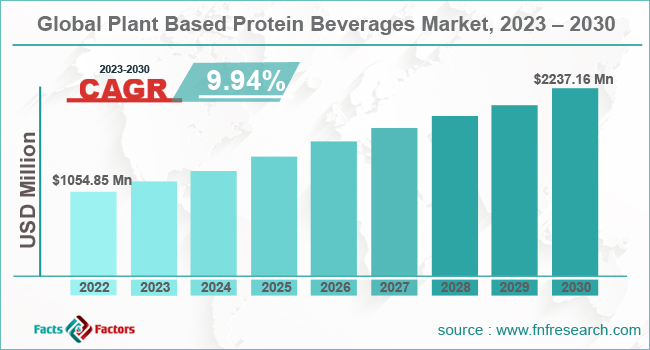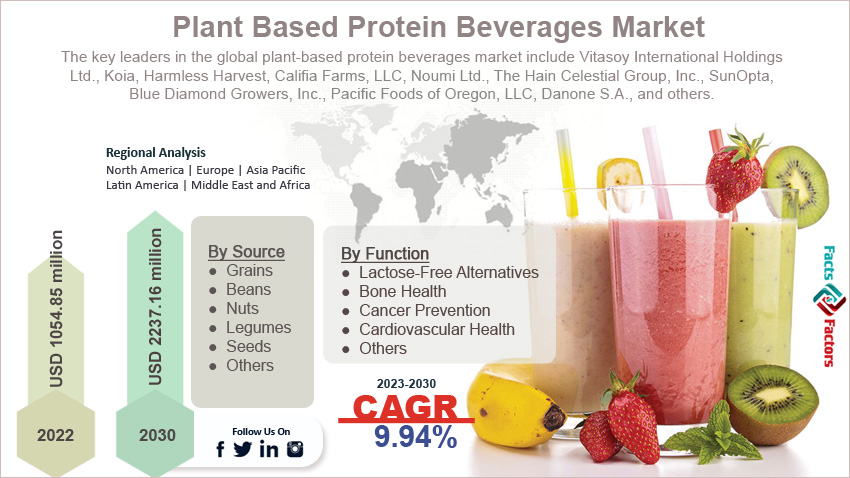Search Market Research Report
Plant Based Protein Beverages Market Size, Share Global Analysis Report, 2023 – 2030

Plant Based Protein Beverages Market Size, Share, Growth Analysis Report By Function (Lactose-Free Alternatives, Bone Health, Cancer Prevention, Cardiovascular Health, And Others), By Source (Grains, Beans, Nuts, Legumes, Seeds, And Others), By Type (Organic and Conventional), By Distribution Channel (Online Stores, Convenience Stores, Specialty Stores, Modern Trade, And Other Stores), And By Region - Global and Regional Industry Insights, Overview, Comprehensive Analysis, Trends, Statistical Research, Market Intelligence, Historical Data and Forecast 2023 – 2030
Industry Insights
[230+ Pages Report] According to Facts and Factors, the global plant-based protein beverages market size was valued at USD 1054.85 million in 2022 and is anticipated to reach USD 2237.16 million during the forecast period. The market is likely to grow with a CAGR of 9.94% between 2023-2030.

 Market Overview
Market Overview
Plant-based protein beverages are plant-derived protein-sourced beverages. These drinks are great alternatives to conventional dairy-based products. These are highly chosen by individuals following plant-based, vegan, vegetarian, or flexitarian diets. Plant-based beverages are a great source of minerals, vitamins, and protein.
These beverages offer a good amount of protein per serving which is important for satiety, muscle maintenance, overall health, etc.
 Key Insights
Key Insights
- As per the analysis shared by our research analyst, the global plant-based protein beverages market size is estimated to grow annually at a CAGR of around 9.94% over the forecast period (2023-2030).
- In terms of revenue, the global plant-based protein beverages market size was valued at around USD 1054.85 million in 2022 and is projected to reach USD 2237.16 million by 2030.
- The fast-growing middle class is expected to positively influence the growth of the global plant-based protein beverages market.
- Based on the function, the lactose-free alternative segment accounts for the largest share of the global market.
- Based on the source, soy is the fastest-growing segment of the global market.
- Based on the type, the organic segment is expected to register a high growth rate in the global market.
- Based on distribution channels, the convenience store segment is likely to dominate the global market.
- Based on region, North America is expected to dominate the global market during the forecast period.

 Growth Drivers
Growth Drivers
- Fast-growing middle class is likely to accentuate the growth of the global market.
The rising middle class in countries like India, China, Japan, and other South Asian nations is driving huge demand for premium health products that include plant-based protein beverages, which in turn is likely to revolutionize the global plant-based protein beverages market in the forthcoming years.
Additionally, the fast-growing population in the region is another major reason for the high growth rate of the industry. For instance, Danone introduced a Dairy & Plants Blend baby formula to align with the parent’s demand for feeding alternatives ideal for flexitarian, vegetarian, and other plant-based diets to fulfill the infant’s specific nutritional needs.
 Restraints
Restraints
- Nutritional concerns are likely to hamper the growth of the global market.
Though plant-based beverages hold the ability to fulfill the daily nutritional requirements of the human body, consumers still have certain concerns in their mind regarding the presence of amino acid profiles, protein quality, and other micronutrient content. This is likely to restrain the growth of the global plant-based protein beverages industry in the forthcoming years.
 Opportunities
Opportunities
- Investments and partnerships are likely to offer lucrative growth opportunities in the global market.
Several startups are spurring up, which are partnering with food companies to supply plant-based food and beverages to the local stores to reach a wider audience. This partnership is bridging the gap between the supply and demand for plant-based beverages, which is likely to boost the opportunities in the plant-based protein beverages industry in the coming years.
For instance, Gaia’s Farming Co., in January 2022, introduced its first two milk alternatives with distinct flavors like oats and hemp to serve a constantly increasing vegan population.
 Challenges
Challenges
- Competition with traditional beverages is a big challenge in the global market.
Beverages are facing tough competition with traditional beverages like fruit juices, dairy milk, energy drinks, etc., which have a larger fan base. Lack of similar taste and texture as traditional dairy-based products is a big challenge in the global plant-based protein beverages market.
 Segmentation Analysis
Segmentation Analysis
The global plant-based protein beverages market can be segmented into function, source, type, distribution channel, and region.
By function, the market can be segmented into lactose-free alternatives, bone health, cancer prevention, cardiovascular health, and others. Lactose-free alternative segment accounts for the largest share of the global plant-based protein beverages industry.
The food and beverage sector is witnessing substantial growth due to shifting consumer preferences, dairyenvironmental sustainability, animal welfare, and health considerations. Increasing cases of lactose intolerance is one of the major factors boosting the growth of the segment. The surge in the vegetarian and flexitarian lifestyle is significantly widening the scope of plant-based diets as they align with daily dietary preferences.
By source, the market can be segmented into grains, beans, nuts, legumes, seeds, and others. Soy is the fastest-growing segment of the global plant-based protein beverages market. The growth can be attributed to the fact that soy is the complete protein source that contains all the important amino acids required by the human body.
Additionally, soy is associated with a lot of health benefits like potential hormone balance, cholesterol management, and good heart health owing to its isoflavone content. Soy-based protein can be included in a wide range of products like meat, milk, and yogurt alternative beverages.
Its versatility helps manufacturers to innovate a large variety of plant-based protein beverages, therefore it is accentuating the growth of the segment during the forecast period.
By type, the market can be segmented into organic and conventional. The organic segment is expected to register a high growth rate during the forecast period due to the increasing health and sustainability consciousness among people. People view organic products as more environmentally friendly and healthy than the other available options.
Organic products come with a clean label which resonates with people looking for minimally processed food products. Organic products are manufactured without any antibiotics, hormones, or synthetic pesticides, which helps in improving the quality of the food products, thereby appealing to a wider customer base.
By distribution channel, the market can be segmented into online stores, convenience stores, specialty stores, modern trade, and other stores. The convenience store segment is likely to dominate the plant-based protein beverages industry during the forecast period.
People are more likely to visit convenience stores for easy on-the-go consumption options. The plant-based beverages are portable in nature and convenient to use, which act as a high source of nutrition for busy individuals. Also, convenience stores have extended their product offering in order to deliver products according to consumer preferences to increase their reach.
 Report Scope
Report Scope
Report Attribute |
Details |
Market Size in 2022 |
USD 1054.85 Million |
Projected Market Size in 2030 |
USD 2237.16 Million |
CAGR Growth Rate |
9.94% CAGR |
Base Year |
2022 |
Forecast Years |
2023-2030 |
Key Market Players |
Vitasoy International Holdings Ltd., Koia, Harmless Harvest, Califia Farms LLC, Noumi Ltd., The Hain Celestial Group Inc., SunOpta, Blue Diamond Growers Inc., Pacific Foods of Oregon LLC, Danone S.A., and Others. |
Key Segment |
By By Function, By Source, By Type, By Distribution Channel, and Region |
Major Regions Covered |
North America, Europe, Asia Pacific, Latin America, and the Middle East &, Africa |
Purchase Options |
Request customized purchase options to meet your research needs. Explore purchase options |
 Regional Analysis
Regional Analysis
- North America holds the largest share of the global market.
North America accounts for the largest share of the global plant-based protein beverages market because of increasing environmental concerns, health consciousness, and animal welfare issues. However, consumers in the region are looking for the ideal alternatives to traditional dairy products that can offer a good amount of nutrition required by the human body.
Moreover, people in North America are shifting towards flexitarian diets to reduce the consumption of animal-based products, which is likely to offer lucrative growth opportunities in the market. Manufacturers are also introducing new beverage options from various sources like oats, almonds, soy, and others to attract a wider consumer base and cater to diverse consumer preferences. Therefore, the region is expected to witness notable growth in total revenue in the coming years.
Asia Pacific is anticipated to witness a steady growth rate in the coming years because of the diverse cultures in the region. Increasing health consciousness and changing dietary habits of the people are likely to contribute heavily towards the high growth rate of the regional market. Asian countries hold the tradition of consuming plant-based diets from various sources like lentils, tofu, soy, and more which in turn is likely to attract investors to the region.
As a result of increased modernization and urbanization in the region, people are looking forward to nutrition and convenient food sources, which can help them to fulfill their dietary requirements in their busy schedules. For instance, Archer Daniels Midland Company in 2019, launched its first protein beverage in Thailand. The product is completely plant-based and comes in a Mocha flavor with a goal of company expansion in the region.
 Competitive Analysis
Competitive Analysis
The key leaders in the global plant-based protein beverages market include:
- Vitasoy International Holdings Ltd.
- Koia
- Harmless Harvest
- Califia Farms LLC
- Noumi Ltd.
- The Hain Celestial Group Inc.
- SunOpta
- Blue Diamond Growers Inc.
- Pacific Foods of Oregon LLC
- Danone S.A.
For instance, Conagra Brands in May 2021 launched a new Suprême Plant-Based Burger to extend its Gardein meat alternatives in Canada.
The global plant-based protein beverages market is segmented as follows:
 By Function Segment Analysis
By Function Segment Analysis
- Lactose-Free Alternatives
- Bone Health
- Cancer Prevention
- Cardiovascular Health
- Others
 By Source Segment Analysis
By Source Segment Analysis
- Grains
- Beans
- Nuts
- Legumes
- Seeds
- Others
 By Type Segment Analysis
By Type Segment Analysis
- Organic
- Conventional
 By Distribution Channel Segment Analysis
By Distribution Channel Segment Analysis
- Online Stores
- Convenience Stores
- Specialty Stores
- Modern Trade
- Other Stores
 By Regional Segment Analysis
By Regional Segment Analysis
- North America
- The U.S.
- Canada
- Mexico
- Europe
- France
- The UK
- Spain
- Germany
- Italy
- Rest of Europe
- Asia Pacific
- China
- Japan
- India
- Australia
- Southeast Asia
- Rest of Asia Pacific
- The Middle East & Africa
- Saudi Arabia
- UAE
- Egypt
- Kuwait
- South Africa
- Rest of the Middle East & Africa
- Latin America
- Brazil
- Argentina
- Rest of Latin America
Industry Major Market Players
Frequently Asked Questions

Copyright © 2024 - 2025, All Rights Reserved, Facts and Factors


